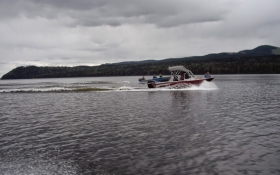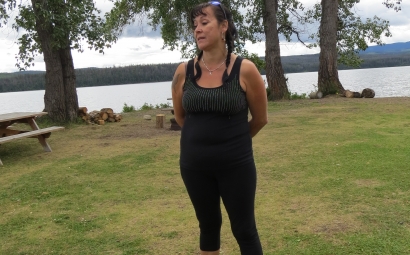Understanding Aboriginal Rights and Treaty rights
Understanding Aboriginal Rights
and Treaty Rights
By
George Nicholson, LLB.
Goals of this Presentation
• Better understanding Aboriginal Rights and Aboriginal Title, including some important differences
• Better understand the approach to First Nation lands taken by modern treaties
• Better understand what lands and consultation might look like in a pre-treaty and post-treaty context
Aboriginal Rights
• First Nations have Aboriginal rights based on the way they traditionally used their lands
• Aboriginal rights are protected by s. 35 of the Constitution Act, 1982
• Aboriginal rights are defined by decisions of the courts
• There are some important differences between Aboriginal title and all other
Aboriginal Rights and Aboriginal Title
Important quotes from the Delgamuukw case:
“Although Aboriginal title is a species of Aboriginal right recognized and affirmed by s. 35(1), it is distinct from other Aboriginal rights.” (at para. 137)
“Aboriginal rights which are recognized by s. 35(a) fall along a spectrum with respect to their degree of connection with the land. At the one end are those aboriginal rights which are practices, customs and traditions integral to the distinctive aboriginal culture of the group claiming the right but where the use and occupation of the land where the activity is taking place is not sufficient to support a claim of title to the land... At the other end of the spectrum is aboriginal title itself which confers more than the right to engage in site-specific activities.” (at para. 138)
“Aboriginal title is a right in land.” (at para. 111)
Comparison of Differences
Aboriginal Title
• A unique kind of ownership of land
• Right to exclusive use of the land
• Typical Example: where First Nations had villages
Aboriginal Rights (excluding Aboriginal Title)
• Right to use but NOT to own the land
• Generally not exclusive rights
• Typical example: seasonal hunting
The Shape of Aboriginal Title
• The courts say that Aboriginal title continues to exist in BC but have never once declared that a First Nation holds Aboriginal title in a specific parcel of land
• So where does a First Nation have Aboriginal title?
• How much of a First Nation's traditional territory is Aboriginal title?
Proof of Rights and Title
Aboriginal Title
(test for proof from Delgamuukw)
• Claims are based on FN use of land at the assertion of Crown sovereignty, 1846
• FN's have title on lands that they made “regular use” (para. 149) of and were of “central significance” (para. 150) to them
• In R. v. Adams [1996], the SCC concluded seasonal use of lands was insufficient for a claim to title but sufficient for a claim to other rights
Aboriginal Rights (excluding Aboriginal Title)
(test for proof from R. v. Sparrow and R. v. Van der Peet)
• Based on use of land at first contact (late 1700's and early 1800's depending on the First Nation)
• The activity must have been a practice or a custom that was “integral” and “distinctive” to the First Nation
• Seasonal use may still lead to Aboriginal rights
William Case
• The Tsilhqot'in v. British Columbia (aka William case) was heard by the SCC on November 7, 2013
• The final decision should be received in the next few months
• Some statements made by the BC Court of Appeal include:
- Occupation of lands is not necessarily enough to rely upon to prove Aboriginal title (para. 206)
- First Nations cannot claim lands on a territorial basis (para. 220)
- For a First Nation to claim Aboriginal title throughout its traditional territory is not consistent with the spirit of reconciliation (para. 219)
Infringement of Aboriginal Rights and Title
“The aboriginal rights recognized and affirmed by s. 35(1), including Aboriginal title, are not absolute. Those rights may be infringed, both by the federal (e.g., Sparrow) and provincial (e.g., Cote) governments.”
- Delgamuukw at para. 160
“In my opinion, the development of agriculture, forestry, mining, and hydroelectric power, the general economic development of the interior of British Columbia, protection of the environment or endangered species, the building of infrastructure and the settlement of foreign populations to support those aims, are the kinds of objectives that are consistent with this purpose and, in principle, can justify the infringement of aboriginal title.”
- Delgamuukw at para. 165
Favouring Good Faith Negotiations
• Ultimately, the Supreme Court of Canada has shown a considerable reluctance to resolve land claims themselves
“Finally, this litigation has been both long and expensive, not only in economic but in human terms as well. By ordering a new trial, I do not necessarily encourage the parties to proceed to litigation and to settle their dispute through the courts. As was said in Sparrow, at p. 1105, s. 35(1) “provides a solid constitutional basethe Crown is under a moral, if not a legal, duty to enter into and conduct those negotiations in good faith. Ultimately, it is through negotiated settlements, with good faith and give and take on all sides, reinforced by the judgments of this Court, that we will achieve what I stated in Van der Peet, supra, at para. 31, to be a basic purpose of s. 35(1) -- “the reconciliation of the pre-existence of aboriginal societies with the sovereignty of the Crown”. Let us face it, we are all here to stay.
Treaty Model
• A treaty essentially defines two categories of land:
- Treaty Settlement Lands (TSL), &
- Harvest Areas
• Treaties recognize First Nation ownership of tens or hundreds of thousands of hectares of TSL
• Treaties recognize harvesting and consultation rights throughout the entire traditional territory, including hunting & fishing rights
Treaty Settlement Lands
• TSL are lands that a treaty nation may use exclusively
• TSL is held by a First Nation in fee simple, the same kind of ownership that most home owners enjoy
• First Nations receive law-making on TSL
• First Nations receive land management over TSL
Harvest Areas
• Harvest Areas cover the entire traditional territory of a First Nation
• Harvest Areas set out the right to hunt, fish and gather similar
• LBN still must be consulted if the government affects the Harvest Areas and LBN harvesting rights
• LBN will probably also set Protected Areas in the treaty
TSL and Aboriginal Title
Treaty Settlement Lands
• Can be sold to anyone in accordance with First Nation Law and Constitution
• Can be expropriated if the government can show it has: a valid public purpose, has no other reasonably feasible alternative, and takes the least possible interest for the shortest possible time
• Limited by provisions in the treaty in regard to expropriation
Aboriginal Title
• Can only be sold through the Crown who must ensure communal benefit
• Is subject to “justifiable infringement”, which is possible where the crown can show they have balanced their power with their duty to deal honourably with First Nation
• Subject to common law limitations in regard to justifiable infringement
Consultation: Harvest Areas and Aboriginal Rights
Harvest Areas
• First Nations are guaranteed rights to hunt, fish and gather in accordance with the treaty and First Nation law
• Under treaty, Canada and BC are still required to consult First Nations for decisions that may affect their treaty rights or treaty lands
• First Nation consent is normally not required in Harvest Areas
Aboriginal Rights (excluding Title)
• First Nations have rights to hunt, fish and gather in accordance with the case law
• Canada and BC are required to consult for anything that might affect a First Nations Aboriginal rights
• First Nation ability to demand accommodation is not as strong on lands where it cannot make a claim to Aboriginal title
Key Lessons
• Aboriginal title is a unique kind of Aboriginal right
• Unless the reasons of the William decision are significantly altered by their appeal to the Supreme Court of Canada, First Nations who continue to negotiate with the crown and third-parties claiming Aboriginal title throughout their traditional territory are not likely to gain the support of the courts
• The courts are more likely to support a First Nation who demonstrates a willingness to negotiate with the crown, third-parties and other First Nations in good faith
• Aboriginal rights and treaty rights are complex and difficult to compare
Cases Cited
All cases cited are available for free on the Internet at
www.canlii.org
Delgamuukw v. British Columbia, [1997] 3 S.C.R. 1010 (SCC) Haida v. Minister of Forests, [2004] 3 S.C.R. 511 Tsilhqot'in v. British Columbia, [2012] BCCA285 **
R. v. Sparrow, [1990] 1 S.C.R. 1075
R. v. Van der Peet, [1996] 2 S.C.R. 507
R. v. Adams, [1996] 3 S.C.R. 101
** on appeal to the Supreme Court of Canada now
Thank You
George Nicholson Website: www.nicholsonlaw.ca





